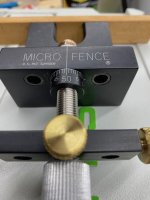DynaGlide
Member
- Joined
- May 16, 2017
- Messages
- 1,697
Was this discussed already?
https://www.woodpeck.com/multi-function-router-base.html
https://www.youtube.com/redirect?event=video_description&redir_token=QUFFLUhqa3E0ZXhLU0xwYmswV21zNUpmRVV2ZlJ2ZnJrd3xBQ3Jtc0tudnRZOFROWWdyd3J4MjY1Q0VTVkZhYjRGbmc1WnZyajB3dFRIalB4c2haZ0tMTDB3cVAxUTNSeXQ4R1BtWkhiYXhfMkxOTm5zWDNoZDk5czdVZmV2YkxydWhxOWxwd1hjRnNHbFlkYUpoOXVNcUFaUQ&q=https%3A%2F%2Fwww.woodpeck.com%2Fmulti-function-router-base.html
I've avoided any extra doohickey gadgets for my Festool routers thus far (except the kerf maker jig) because the guide rail is so versatile. This one looks like it might actually be worth it though.
Matt
https://www.woodpeck.com/multi-function-router-base.html
https://www.youtube.com/redirect?event=video_description&redir_token=QUFFLUhqa3E0ZXhLU0xwYmswV21zNUpmRVV2ZlJ2ZnJrd3xBQ3Jtc0tudnRZOFROWWdyd3J4MjY1Q0VTVkZhYjRGbmc1WnZyajB3dFRIalB4c2haZ0tMTDB3cVAxUTNSeXQ4R1BtWkhiYXhfMkxOTm5zWDNoZDk5czdVZmV2YkxydWhxOWxwd1hjRnNHbFlkYUpoOXVNcUFaUQ&q=https%3A%2F%2Fwww.woodpeck.com%2Fmulti-function-router-base.html
I've avoided any extra doohickey gadgets for my Festool routers thus far (except the kerf maker jig) because the guide rail is so versatile. This one looks like it might actually be worth it though.
Matt

